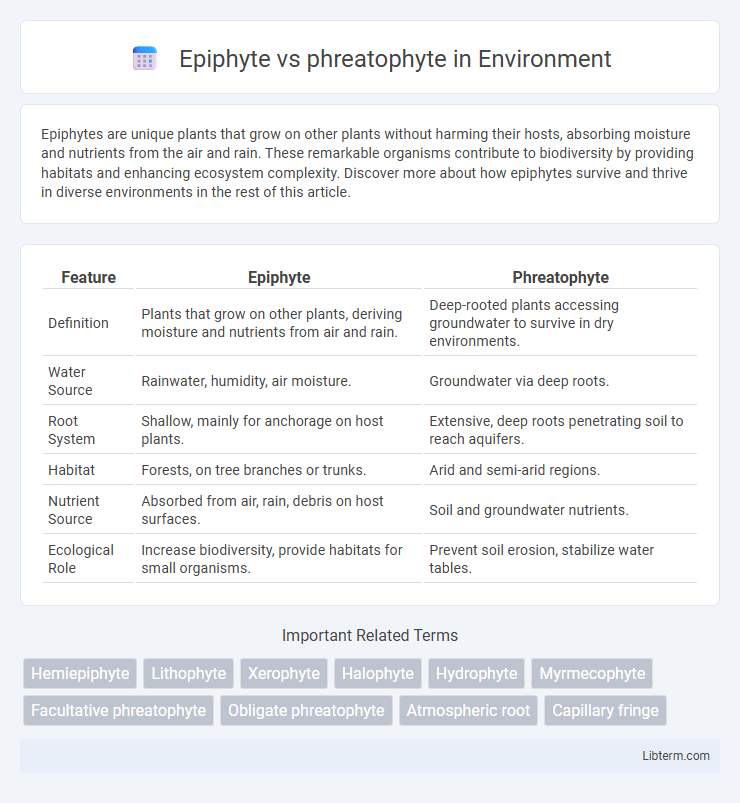Epiphytes are unique plants that grow on other plants without harming their hosts, absorbing moisture and nutrients from the air and rain. These remarkable organisms contribute to biodiversity by providing habitats and enhancing ecosystem complexity. Discover more about how epiphytes survive and thrive in diverse environments in the rest of this article.
Table of Comparison
| Feature | Epiphyte | Phreatophyte |
|---|---|---|
| Definition | Plants that grow on other plants, deriving moisture and nutrients from air and rain. | Deep-rooted plants accessing groundwater to survive in dry environments. |
| Water Source | Rainwater, humidity, air moisture. | Groundwater via deep roots. |
| Root System | Shallow, mainly for anchorage on host plants. | Extensive, deep roots penetrating soil to reach aquifers. |
| Habitat | Forests, on tree branches or trunks. | Arid and semi-arid regions. |
| Nutrient Source | Absorbed from air, rain, debris on host surfaces. | Soil and groundwater nutrients. |
| Ecological Role | Increase biodiversity, provide habitats for small organisms. | Prevent soil erosion, stabilize water tables. |
Introduction to Epiphytes and Phreatophytes
Epiphytes are plants that grow non-parasitically upon other plants, deriving moisture and nutrients from the air, rain, and debris accumulating around them, commonly found in tropical rainforests. Phreatophytes are deep-rooted plants accessing groundwater through extended root systems, often inhabiting arid and semi-arid regions where surface water is scarce. Both plant types exhibit specialized adaptations for survival in diverse ecological niches, reflecting distinct water acquisition strategies essential to their respective environments.
Defining Epiphytes: Life Above Ground
Epiphytes are plants that grow non-parasitically on other plants, deriving moisture and nutrients from the air, rain, and debris accumulating around them. Unlike phreatophytes, which access deep underground water through extended root systems, epiphytes thrive entirely above ground without soil contact. This adaptation allows epiphytes to colonize tree branches and other elevated surfaces in diverse ecosystems, particularly tropical rainforests.
Understanding Phreatophytes: Deep Root Water Seekers
Phreatophytes are plants with deep root systems that access groundwater through the phreatic zone, enabling survival in arid and semi-arid environments where surface water is scarce. Unlike epiphytes, which absorb moisture and nutrients directly from the air and rain, phreatophytes rely on their extensive root depth to tap into underground water sources. This adaptation allows them to maintain growth and physiological functions during prolonged droughts by efficiently extracting water from deep soil layers.
Key Differences Between Epiphytes and Phreatophytes
Epiphytes grow non-parasitically on other plants, deriving moisture and nutrients from the air and rain, while phreatophytes extend deep roots into groundwater to access water in arid environments. Epiphytes rely on aerial root systems for survival, whereas phreatophytes possess extensive root networks that penetrate soil layers reaching water tables. Adaptations in water acquisition and habitat preferences fundamentally distinguish epiphytes from phreatophytes.
Ecological Roles in Their Respective Habitats
Epiphytes play a crucial ecological role in forest canopies by enhancing biodiversity and creating microhabitats for various organisms without extracting nutrients from the soil. Phreatophytes stabilize riparian ecosystems by accessing deep groundwater, which supports water cycles and prevents soil erosion in arid and semi-arid regions. Both plant types contribute significantly to nutrient cycling and habitat complexity, adapting uniquely to their specific environmental niches.
Adaptations for Water Acquisition
Epiphytes adapt to water scarcity by developing specialized structures such as trichomes and velamen roots that efficiently capture moisture from rain, fog, and air humidity. Phreatophytes possess deep, extensive root systems that tap directly into groundwater sources, allowing survival in arid environments by accessing water unavailable to surface-rooted plants. These contrasting adaptations highlight evolutionary strategies for optimizing water acquisition in diverse ecological niches.
Examples of Common Epiphytes
Common epiphytes include orchids, bromeliads, and ferns, which thrive by growing on the surface of trees without extracting nutrients from the soil. These plants obtain moisture and nutrients from the air, rain, and debris accumulating around them, making them well-adapted to humid tropical forests. Unlike phreatophytes such as willows and mesquite that rely on deep groundwater, epiphytes maximize photosynthesis and survival by occupying elevated, light-rich environments.
Notable Phreatophyte Species
Notable phreatophyte species such as mesquite (Prosopis spp.), cottonwood (Populus deltoides), and saltcedar (Tamarix ramosissima) exhibit deep root systems that access groundwater, allowing them to thrive in arid and semi-arid environments. These phreatophytes play a crucial role in riparian ecosystems by stabilizing soil and maintaining water tables. Unlike epiphytes, which absorb moisture from the air and grow on other plants, phreatophytes are rooted directly in the soil with access to subsurface water sources.
Importance in Ecosystem Biodiversity
Epiphytes enhance ecosystem biodiversity by providing microhabitats and increasing plant diversity in forest canopies, thus supporting diverse animal species and promoting nutrient cycling. Phreatophytes contribute to ecosystem stability by accessing deep groundwater, maintaining soil moisture, and supporting riparian habitats critical for wildlife survival. Both plant types play essential roles in sustaining complex food webs and ecological resilience in their respective environments.
Human Uses and Conservation Considerations
Epiphytes, valued for their ornamental appeal and air-purifying capabilities, contribute to urban greening and biodiversity conservation efforts, while phreatophytes play a crucial role in stabilizing groundwater levels and preventing soil erosion in arid regions, supporting sustainable agriculture and water management. Conservation strategies for epiphytes emphasize habitat preservation in tropical forests to maintain ecosystem balance and protect endangered species, whereas protecting phreatophytes involves managing water extraction and mitigating habitat destruction to ensure the resilience of riparian ecosystems. Both types of plants are integral to ecological health, necessitating targeted conservation policies to sustain their environmental benefits and human utility.
Epiphyte Infographic

 libterm.com
libterm.com